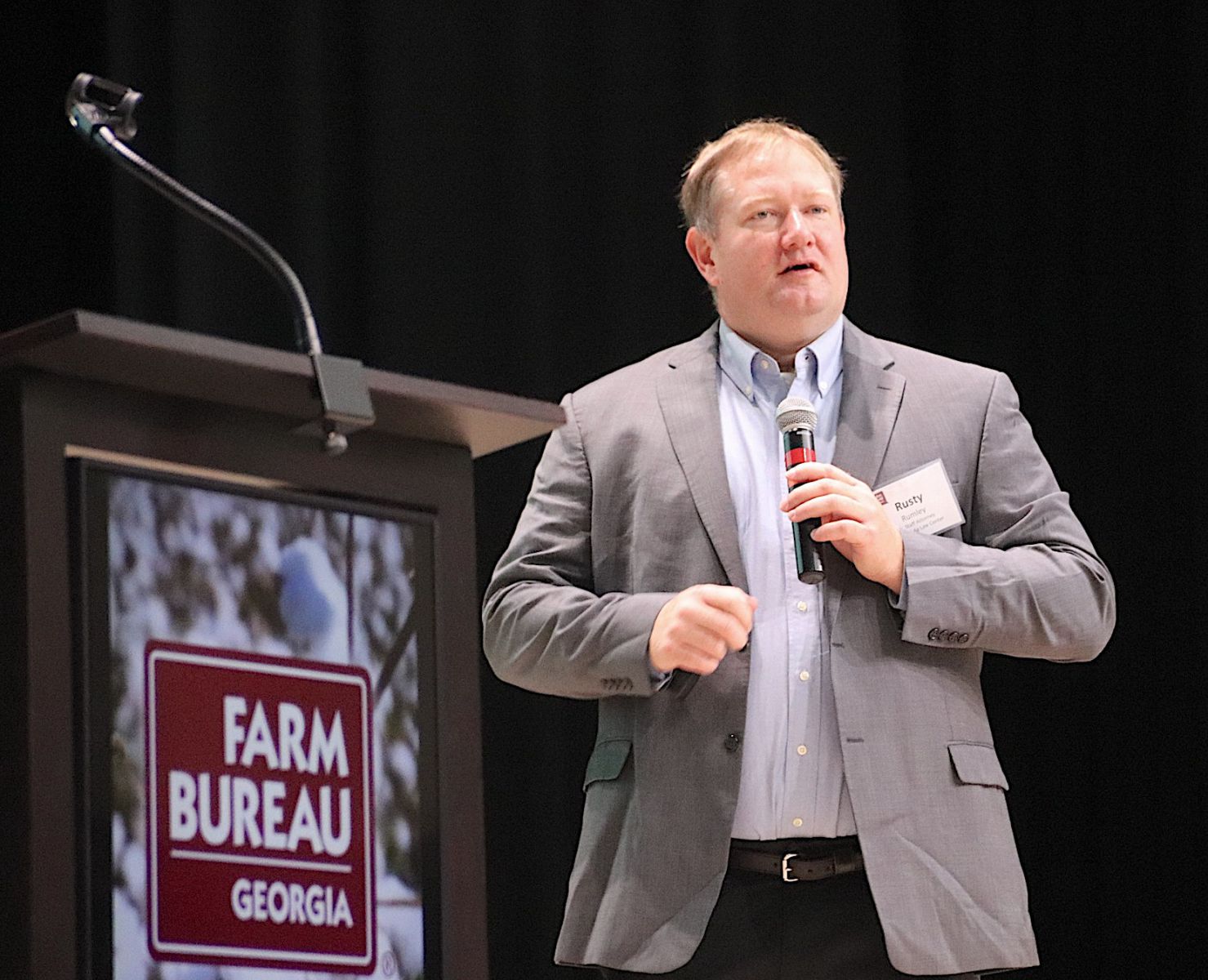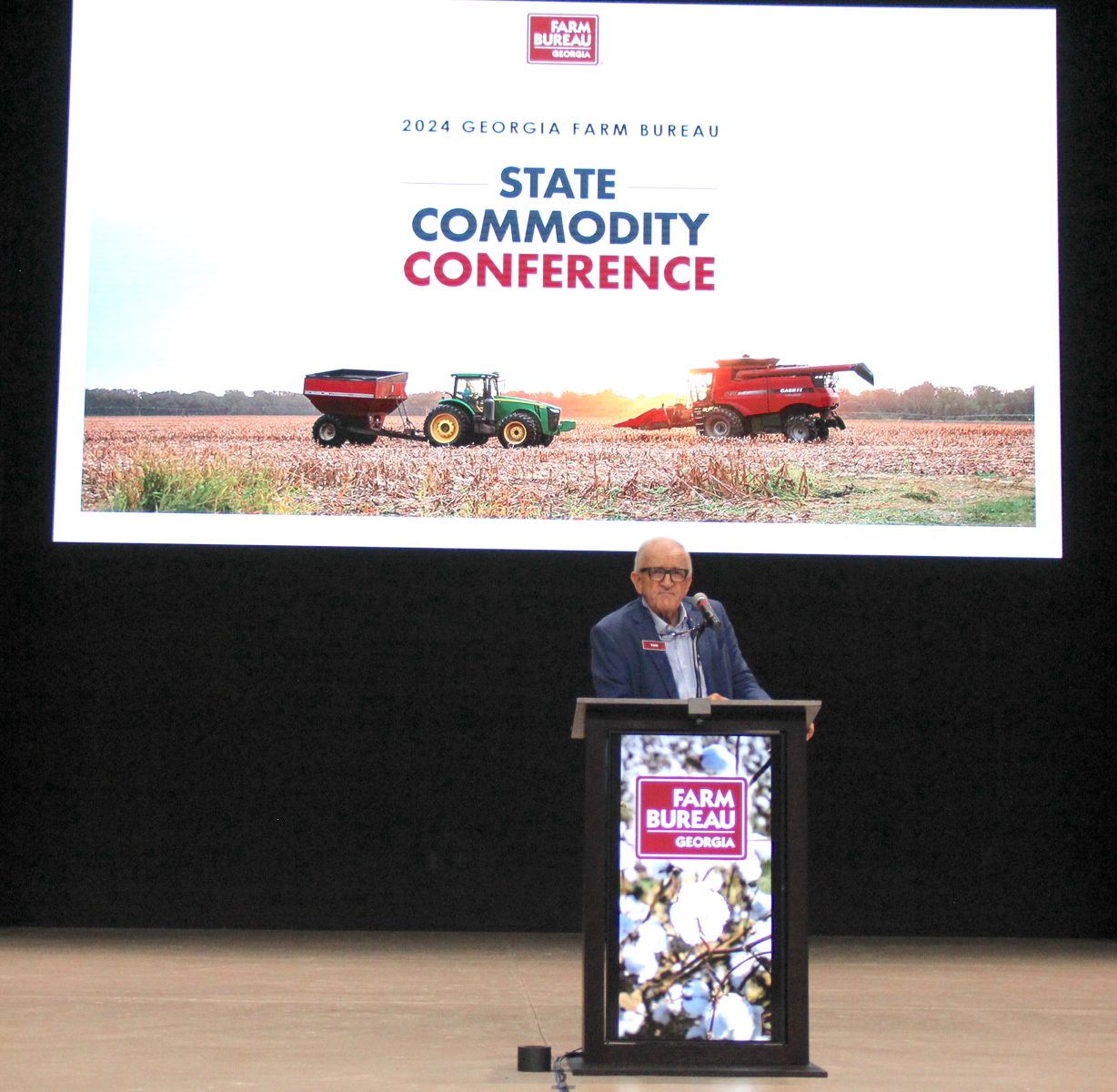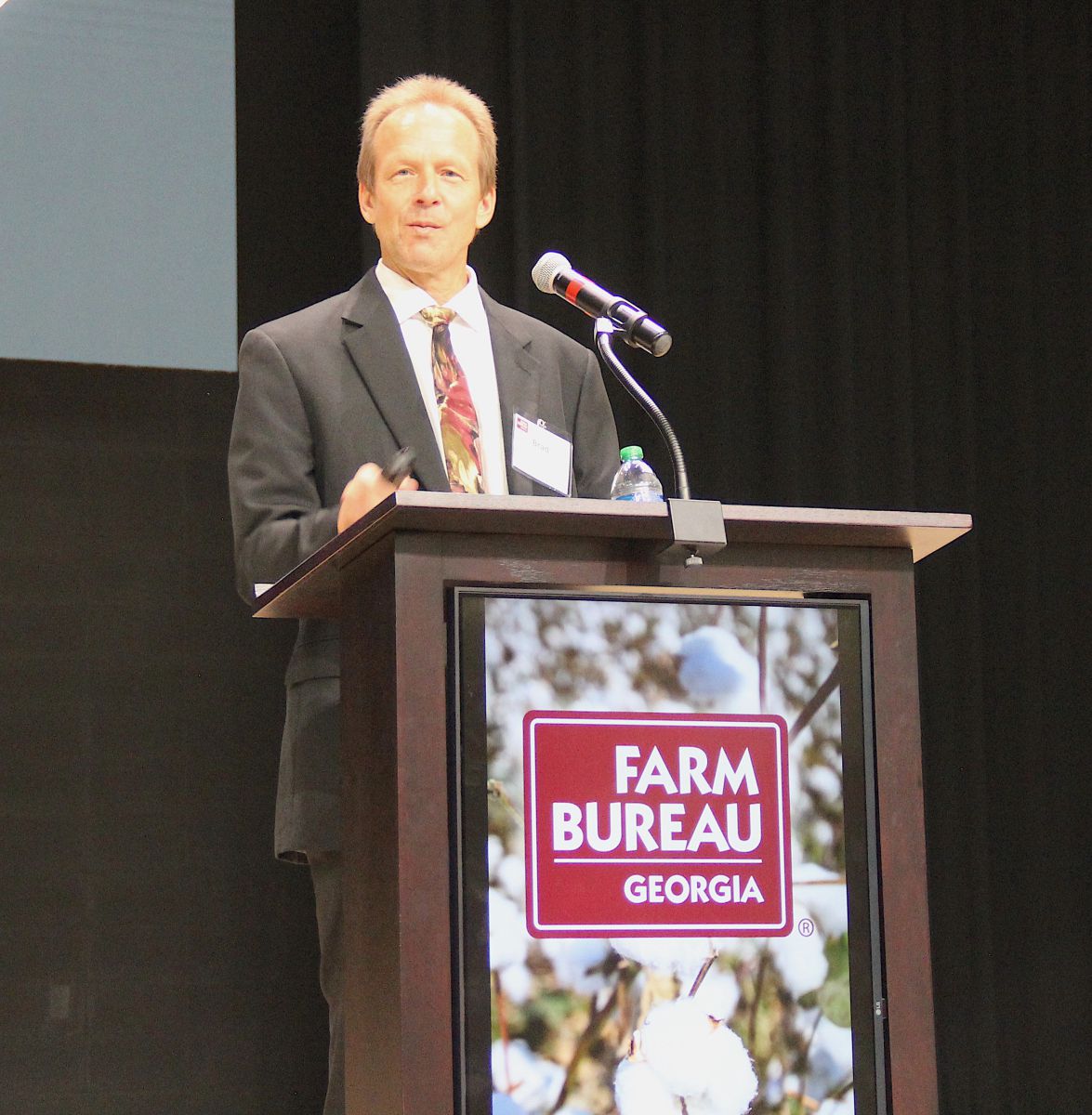Ag News
Weather, economy and politics key topics at GFB Commodity Conference
Posted on Aug 16, 2024 at 5:52 AM
By Jay Stone & Jennifer Whittaker
The 2024 Georgia Farm Bureau Commodity Conference on Aug. 8 in Tifton gave the organization’s 20 commodity advisory committees a chance to begin considering policy stances for 2025.
“We’re glad to see all of you here today. We appreciate you taking time away from your farms, especially those of you who experienced Tropical Storm Debby earlier this week. This meeting kicks off our policy development process of getting our members’ input on issues affecting your farms and agriculture," GFB President Tom McCall said. "Developing our policy is the most important thing we do and it starts at the local level in your counties and with those of you serving on our commodity committees telling us what position you want Farm Bureau to take on legislation and agency regulations discussed in Atlanta and D.C.”
GFB President Tom McCall thanks GFB Commodity Committee members for attending the organization's annual commodity conference. / Photo by Jennifer Whittaker
Conference attendees also heard presentations on state government, weather, land values, farm-related legal issues, the economy and the political landscape. Here’s a look:
Harper summarizes GDA work
Georgia Agriculture Commissioner Tyler Harper praised Georgia Farm Bureau for its advocacy efforts and reviewed some of the work the Georgia Department of Agriculture (GDA) is doing to support Georgia's farmers and consumers./ Photo by Jay Stone
Harper said the department has created a separate division specifically for farmers markets. GDA has named Lindsey Brown as division director to oversee the markets.
Harper noted that the state legislature allocated $37.5 million for infrastructure improvements at the Atlanta State Farmers Market.
“We are building out a team that will focus solely on our farmers markets and ensuring that they have the needed resources and staff to be able to provide that access to market,” Harper said. “The farmers markets are different today than they were when they were built in the 1950s and in a lot of different capacities. But the mission still is the same in providing our producers, our farmers with an avenue to sell their product to a consumer.”
The commissioner said the GDA is still challenged with hiring people to carry out its functions, including issuing some 80,000 licenses and conducting more than 125,000 inspections per year.
“When I walked in the door, we had about 130 vacancies in the department,” Harper said. “We still have around 90, which is significant for us because it makes it a lot more difficult obviously for us to do the job that we've been tasked with every single day.”
He said the legislature helped by authorizing 4% raises for state employees and an extra $2,000 for GDA inspectors.
Harper discussed agricultural land conservation and foreign ownership of agricultural land. The legislature passed the Georgia Farmland Conservation Act, which establishes the Georgia Farmland Conservation Fund. The legislature budgeted $2 million to support the fund, which is a conservation easement program through which farmland can be protected and kept for agricultural purposes. The Farmland Conservation Fund is modeled after a land conservation program used in Florida.
“It's a way to protect ag land in our state,” Harper said.
He mentioned the work of the GDA’s law enforcement division, which investigated a food processing facility in South Georgia in the winter that did not have a GDA license. The GDA worked with other state and local law enforcement to raid the facility, seizing $25 million worth of marijuana and arresting four Chinese nationals. The land and facility are owned by a Chinese citizen.
Harper pointed out that a new state law prohibits ownership of agricultural land by citizens or organizations from nations, including China, with adversarial relationships with the state, as well as prohibiting those entities from owning land near military bases in Georgia.
“China has invested in our state in a variety of different ways and that was one of them,” Harper said. “They used a food processing facility as a coverup to run a drug operation on land that they own.”
La Niña expected to continue into next year
USDA Meteorologist Brad Rippey discussed weather patterns Georgia can expect as the world experiences a La Niña weather pattern. / Photo by Jennifer Whittaker
This summer, Georgia experienced its fourth driest June on record for the past 130 years with statewide rainfall averaging just 2.08 inches, Rippey said, less than half what we usually receive in June. Georgia only had a drier June in 1990, 1988 and 1931.
June temperatures made it the 21st hottest June the state has had in 130 years. In the past decade, Georgia has experienced hotter June weather in 2016 and 2022.
Rippey said weather data shows that over the last 50 years Georgia has warmed 1.7˚F for the April – September period. For all months, Georgia has warmed nearly 2.5˚F during the past 50 years.
With the world experiencing a La Niña weather pattern, the water in the Atlantic Ocean is warmer than usual, which increases the chances the U.S. will have more tropical storms/hurricanes. Water temperatures are cooler than usual along the equator in the Pacific Ocean, the U.S. Pacific coast and off the coast of Africa.
The National Oceanic & Atmospheric Administration has predicted 21 such storms for the 2024 hurricane season. As of Aug. 14, five storms have formed, but the season runs through Oct. 31.
“The wild card is all the warm water in the Atlantic, especially in the North Atlantic,” Rippey said. “It’s a big contribution to warm nights. Warm water also affects temperatures on land.”
For historical perspective, the U.S. experienced 30 named storms in 2020, 28 in 2005, 21 in 2021, 20 in 1933 and 2023. The U.S. experienced 15 hurricanes in 2005 (7 major); 14 in 2020 (7 major) and 12 in 2010.
There is a greater than 80% chance the La Niña weather pattern will continue next year. If this happens, Georgia will most likely experience a drier and warmer winter, Rippey said.
“During a La Niña weather pattern, the Southeast U.S. tends to be warm and dry in winter,” Rippey said. “If La Niña lasts into next spring, then that will cause some concern. For the most part, Georgia has gotten through previous La Niñas without it having a major negative impact, with the exception of 2007. We had a warm, early spring that year followed by a drought.”
Georgia land values update

Bryant Peace, a senior advisor with Saunders Ralston Dantzler Real Estate, discusses Georgia land values. / Photo by Jennifer Whittaker
Georgia experienced notable sales volume of ranchland last year, Bryant Peace, a senior advisor with Saunders Ralston Dantzler Real Estate, said because development pressure in Florida is pushing cattle production into Georgia. Last year the average sales price of ranchland between 100-500 acres was $4,108 for 107 verified sales.
“Georgia continues to experience growth and development because industry is expanding, not contracting,” Peace said. “Georgia’s population is growing year over year, and Baby Boomers are retiring and leaving metro areas for rural America.”
Peace said Georgia continues to see a demand for farmland due to its quality soil, water resources and climate and its robust infrastructure for growing, marketing and selling commodities. For 70 verified transactions that Peace’s company had knowledge of, the average price for irrigated farmland averaged $5,555 last year and was $4,053 for nonirrigated land. Pecan orchards sold for an average of $5,913/acre.
Georgia is an exceptional market for anyone wanting to invest in timberland because the state has significant wood processing infrastructure, Peace said. Also, stumpage prices are generally favorable due to consistent mill demand. Last year the average sale price of timberland between 100-500 acres was $2,855 for 105 verified sales.
However, the demand for farms with woods and pasture that are managed for wildlife that fall into the recreational sales category is stronger than timberland. Peace said the average sale price of tracts between 100-500 acres was $4,290 for 239 verified sales last year.
Rumley reviews legal topics

Rusty Rumley, a senior staff attorney with the National Agricultural Law Center, reviewed a variety of legal issues the center is monitoring, including California Proposition 12 and similar state laws, and their requirements that animal products sold in these states come from farms adhering to certain confinement standards. / Photo by Jay Stone
California Proposition 12 and Massachusetts Question 3 were ballot initiatives in which voters in those states supported confinement standards for livestock produced and sold in those states. Proposition 12, which establishes animal confinement standards to pork, veal and eggs, was upheld in the U.S. Supreme Court. A legal challenge to Question 3, Triumph Foods vs. Campbell, was rejected in a July 22 ruling in the U.S. District Court of Massachusetts.
“Agriculture has lost this issue in the courts,” Rumley said.
Other states have similar restrictions. Arizona, Colorado, Michigan, Nevada, Oregon and Washington restrict sales of eggs from producers who do not follow their state’s confinement standards for layer hens, regardless of their place or origin. Florida, Kentucky, Maine, Ohio and Utah have confinement standards that apply to producers in their states. Illinois, Maryland and New York are considering bills that would restrict sales based on animal confinement standards.
Rumley said the trouble with these rulings is they could allow states to pass other laws based on moral grounds, mentioning several scenarios that are now possible because of the court rulings.
“No irrigation being used. How about being carbon neutral? Unless you're carbon neutral, you can't sell in our state. How about minimum wage? Unless you pay a $20 an hour minimum wage, you can't sell your products in our state,” Rumley said. “When you open things up, allow states to regulate other states on morality grounds, it really kind of opens the barn doors.”
Rumley said ultimately processing companies may adopt stricter animal confinement standards as their policy so they do not have to sort out which products can go to what state.
Chevron Deference
Rumley also discussed the Supreme Court decision that overturned the Chevron Deference standard, under which courts would rely on federal agencies to interpret laws in cases where laws in question were unclear. The Supreme Court ruled that it is the courts’ role to interpret laws.
Whether this benefits agriculture might vary from issue to issue and depend on which agency has regulatory authority, Rumley said.
“We really don't know what is going to be impacted, just because agriculture is so heavily regulated, especially at the federal level,” Rumley said. “This is going to be something that we're going to be dealing with this for years.”
Tutterow talks economy, politics
.jpg)
Kennesaw State University Professor Dr. Roger Tutterow presented information about the economic, business and political climate. / Photo by Jay Stone
Tutterow reviewed the progression of prices paid for agricultural inputs compared with prices received by the producer for their commodity. In 2021 and into 2022, prices received went up, Tutterow said.
“That sounds like good news,” he said. “The problem is the prices paid went up as well.”
In some segments of agriculture, prices received went up faster than prices paid.
“We did actually see some compression there, meaning prices received went up faster than prices paid, and that should show up as some expansion in your margin depending, of course, on which segment of the agricultural market you're in,” Tutterow said.
In 2023 and early 2024, prices received dropped significantly, ranging from 15% to 40% and varying by crop.
“If the prices of the inputs that go into providing those products go down as much, it gives you a lot of offset, but in the last year you really haven't gotten as much offset,” Tutterow said.
He touched on challenges with inflation, how consumer sentiments relate to consumer spending and how personal savings have dwindled back to pre-pandemic levels. Businesses, he said, are facing tight labor markets, and the shift to work-from-home culture could end up meaning employers pay wage premiums for jobs that have to be done in person.
“Talk to an HR manager in any industry and they'll tell you particularly as it relates to younger workers, they're losing more prospective employees to the question, ‘Can I work hybrid or remote?’ And so that genie is not going back into the bottle,” Tutterow said.
He noted that the strong U.S. dollar serves to benefit those who are importing goods and is a challenge for those who export goods, including farmers.
Tutterow discussed electoral politics and noted that recent declines in the number of children born in the U.S. and migration within the country from state to state could be key factors in the outcome of the 2024 presidential and congressional elections.
According to the U.S. Census Bureau, the 2020 national birth rate, at just over 60 births per 1,000 women aged 15-44, is at its lowest point since 1920, while the number of births has been relatively flat since the mid-1980s.
The 2023 data from the Tax Foundation showed that six of the 10 states with the largest growth are in the South. Georgia, which grew by 0.5%, ranked 13th. South Carolina had the largest percentage growth at 1.6%. New York had the largest percentage of people to leave the state at 1.1% and the next-largest percentage is California at 0.9%.
Tutterow showed two projected electoral maps from Sabato’s Crystal Ball from the University of Virginia Center for Politics. The projection map from before the Republican National Convention showed Georgia and its 16 electoral votes as a toss-up. Democrat Kamala Harris was projected with 260 electoral votes (270 are needed to win) and Republican Donald Trump was projected with 235. The map from after the RNC showed Georgia leaning Republican. The after-convention map showed five states – Arizona (11 electoral votes), Nevada (6), Wisconsin (10), Michigan (15) and Pennsylvania (19) – as toss-ups. That map forecast 251 votes for Republican Donald Trump and 226 for Democrat Kamala Harris.
Tutterow declined to say who would win the presidency or the House of Representatives. He said his guess was the Senate would flip to Republican control.
“With that in the background, I ask you to support the Farm Bureau here in the state of Georgia,” Tutterow said. “I ask you to spend time with Tom, learn about candidates at the state, local, and federal level that understand the importance that agricultural plays and has always played in the American economy, and support those candidates who embrace the power of entrepreneurial spirit.”
- Categories:
- Tags:


